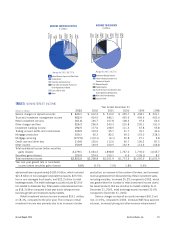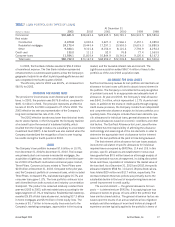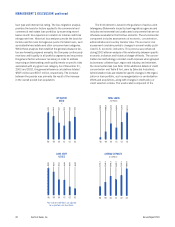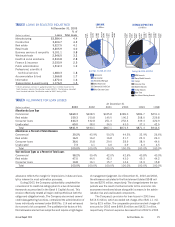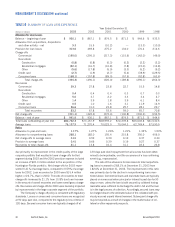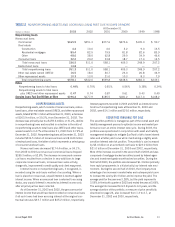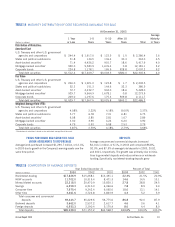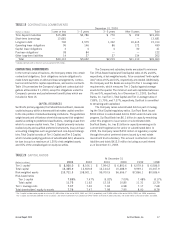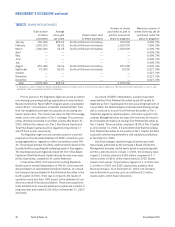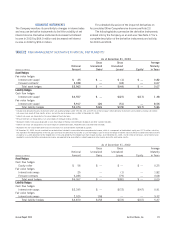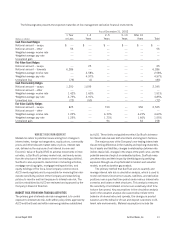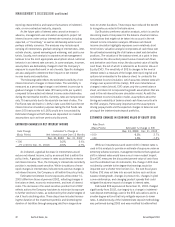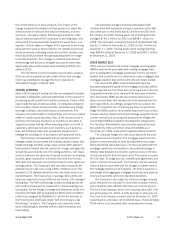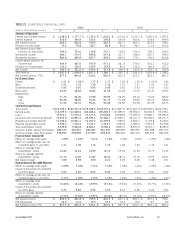SunTrust 2003 Annual Report Download - page 37
Download and view the complete annual report
Please find page 37 of the 2003 SunTrust annual report below. You can navigate through the pages in the report by either clicking on the pages listed below, or by using the keyword search tool below to find specific information within the annual report.
Annual Report 2003 SunTrust Banks, Inc. 35
The increase was due to a combination of Global Bank Note and
Federal Home Loan Bank debt issuances during 2003 to take
advantage of the low interest rate environment and to further
diversify the Company’s funding sources. The Company man-
ages reliance on short-term unsecured borrowings as well as
total wholesale funding through policy established and reviewed
by ALCO.
The Company maintains access to a diversified base of
wholesale funding sources. These sources include fed funds
purchased, securities sold under agreements to repurchase,
negotiable certificates of deposit, offshore deposits, Federal Home
Loan Bank advances, Global Bank Note issuance and commercial
paper issuance. As of December 31, 2003, SunTrust had $6.1 bil-
lion of capacity remaining under its Global Bank Note program
after issuing $850 million in Bank Notes in December of 2003.
Liquidity is also available through unpledged securities in the
investment portfolio and capacity to securitize loans, including
single-family mortgage loans. The Company’s credit ratings are
important to its access of unsecured wholesale borrowings.
Significant changes in these ratings could change the cost and
availability of these sources.
The low rate environment has created heavy refinance
activity and an increase in the amount of mortgage loans origi-
nated by the Company. The Company sells most of these loans
into the secondary market and they are reflected in loans held for
sale. This refinance activity slowed in the second half of 2003,
particularly in the fourth quarter of 2003. Mortgage originations
declined $5.0 billion from fourth quarter of 2002 to a total of
$6.3 billion in the fourth quarter of 2003. Total production in
2003 was $43.7 billion compared to $30.8 billion in 2002. As
of December 31, 2003, the balance of loans held for sale was
$5.6 billion compared to $7.7 billion on December 31, 2002, a
decrease of $2.2 billion. Excluding the addition of Three Pillars
in 2003, net short-term unsecured borrowed funds declined
$2.0 billion during the same period reflecting the reduced fund-
ing need for loans held for sale.
The Company has a contingency funding plan that stress
tests liquidity needs that may arise from certain events such as
agency rating downgrades, rapid loan growth, or significant
deposit runoff. The plan also provides for continual monitoring of
net borrowed funds dependence and available sources of liquid-
ity. Management believes the Company has the funding capacity
to meet the liquidity needs arising from potential events. Liquidity
is measured and monitored for the Bank and Bank Holding
Company. The Company reviews the Parent Holding Company’s
net short-term mismatch. This measures the ability of the hold-
ing company to meet obligations through the sale or pledging of
assets should access to Bank dividends be constrained.
Certain provisions of long-term debt agreements and
Holding Company lines of credit prevent the Company from cre-
ating liens on, disposing of, or issuing (except to related parties)
voting stock of subsidiaries. Further, there are restrictions on
mergers, consolidations, certain leases, sales or transfers of
assets, and minimum shareholders’ equity ratios. As of
December 31, 2003, the Company was in compliance with all
covenants and provisions of these agreements.
TABLE 18
UNFUNDED LENDING COMMITMENTS
(Dollars in millions) At December 31, 2003
Unused lines of credit
Commercial $36,694.4
Mortgage commitments110,665.8
Home equity lines 7,792.2
Commercial real estate 3,650.0
Commercial credit card 576.4
Total unused lines of credit $59,378.8
Letters of credit
Financial standby $9,385.8
Performance standby 265.8
Commercial 191.6
Total letters of credit $9,843.2
1Includes $2,794.6 million in interest rate locks accounted for as derivatives.
OFF-BALANCE SHEET ARRANGEMENTS
In the normal course of business, the Company engages in finan-
cial transactions that, in accordance with accounting principles
generally accepted in the United States, are either not recorded
on the Company’s balance sheet or may be recorded on the
Company’s balance sheet at an amount that differs from the full
contract or notional amount of the transaction. These transac-
tions are structured to meet the financial needs of customers,
manage the Company’s credit, market or liquidity risks, diversify
funding sources or optimize capital.
As a financial services provider, the Company routinely
enters into commitments to extend credit, including, but not lim-
ited to, loan commitments, financial and performance standby
letters of credit and financial guarantees. While these contractual
obligations could potentially result in material current or future
effects on financial condition, results of operations, liquidity, capi-
tal expenditures, capital resources, or significant components of
revenues or expenses, a significant portion of commitments to
extend credit expire without being drawn upon. Such commit-
ments are subject to the same credit policies and approval
processes accorded to loans made by the Company.
The Company has undertaken certain guarantee obligations
in the ordinary course of business. In following the provisions of
FIN 45, as addressed in Note 1, the Company must consider
guarantees that have any of the following four characteristics (i)
contracts that contingently require the guarantor to make pay-
ments to a guaranteed party based on changes in an underlying
factor that is related to an asset, a liability, or an equity security
of the guaranteed party; (ii) contracts that contingently require
the guarantor to make payments to a guaranteed party based on


